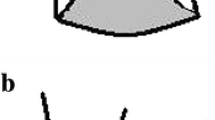Abstract
The aim of this study was to determine the extension of cervical intraepithelial neoplasia grade III (CIN III) into endocervical canal and depth of endocervical crypts involvement by CIN with the regard to patients’ age and parity. Correlation between the area of CIN involvement and the extension into endocervical canal was estimated. A total of 218 cervical cone specimens with histologically proven CIN III were included in this study. Extension of CIN into the endocervical canal, depth of involved crypts and ectocervical area affected by CIN were histologically analyzed. The average endocervical crypt involvement was at 1.2 mm of depth. The excision of >4 mm (1.2 mm × 3S.D.) in depth removes >99% of CIN. With the cone length of 15 mm (nulliparous patients) and 18 mm (multiparous patients), no endocervical cone margins were affected with CIN. Since the cone length is the most important determining factor for fertility preservation, the measurement of cervical cone could be essential for future pregnancies.

Similar content being viewed by others
References
Bosch FX, Manos MM, Munoz N (1995) Prevalence of human papillomavirus in cervical cancer: a worldwide perspective. International biological study on cervical cancer (IBSCC) Study group. J Natl Cancer Inst 87:796–802
Formso S, Hansen MH, Jacobsen BK, Oian P (1996) Pregnancy outcome after laser surgery for cervical intraepithelial neoplasia. Acta Obstet Gynecol Scand 75:139–143
Kurman RJ, Solomon D (1994) The Bethesda System for reporting cervical/vaginal cytologic diagnoses. Springer-Verlag, New York, NY, p 30–78
Nyirjesy I, Billingsley FS, Forman MR (1998) Evaluation of atypical and low-grade cervical cytology in private practice. Obstet Gynecol 92:601–607
Ostor AG (1993) Natural history of cervical intraepithelial neoplasia: a critical review. Int J Gynecol Pathol 12:106
Bjerre B, Eliasson G, Linell F (1976) Conization as only treatment of carcinoma in situ of the uterine cervix. Am J Obstet Gynecol 125:143–152
Reich O, Pickel H, Lahousen M (2001) Cervical intraepithelial neoplasia III: long term outcome after cold-knife conization with clear margins. Obstet Gynecol 97:428–430
DiSaia PJ, Creasman WT (2001) Preinvasive disease of the cervix. In DiSaia PJ, Creasman WT (eds) Clinical gynecologic oncology. Mosby, Inc., St. Louis, p 1–33
Anderson MC, Hartley RB (1980) Cervical crypt involvement by intraepithelial neoplasia. Obstet Gynecol 55:546–550
Coppleson M, Atkinson KH, Dalrymple JC (1992) Cervical squamous and glandular intraepithelial neoplasia: clinical features and review of management. Coppleson M (ed) Gynecological Oncology Vol. 1, Churcill Livingstone, Edinburgh, p 549
Boonstra H, Aalders JG, Koudstaal J, Oosterhuis JW, Janssens J (1990) Minimum extension and appropriate topographic position of tissue destruction for treatment of cervical intraepithelial neoplasia. Obstet Gynecol 75:227–231
Dabic MM, Hlupic L, Babic D, Jukic S, Seiwerth S (2004) Comparison of polymerase chain reaction and catalyzed signal amplification in situ hybridization methods for human papillomavirus detection in paraffin-embedded cervical preneoplastic and neoplastic lesions. Arch Med Res 35:511–516
Perlman SE, Lubianca JN, Kahn JA (2003) Characteristics of a group of adolescents undergoing Loop Electrical Excision Procedure (LEEP). J Pediatr Adolesc Gynecol 16:15–20
Anderson MC, Hartley RB (1980) Cervical crypt involvement by intraepithelial neoplasia. Obstet Gynecol 55:546–550
Ljubojevic N, Babic S, Audy-Jurkovic S, Ovanin-Rakic A, Jukic S, Babic D, Grubisic G, Radakovic B, Ljubojevic-Grgec D (2001) Improved national Croatian diagnostic and therapeutic guidelines for premalignant lesions of the uterine cervix with some cost-benefit aspects. Coll Antropol Dec 25:467–474
Abdul-Karim FW, Fu YS, Reagan JW, Wentz WB (1982) Morphometric study of intraepithelial neoplasia of the uterine cervix. Obstet Gynecol 60:210–214
Ludmir J, Sehdev HM (2000) Anatomy and physiology of the uterine cervix. Clin Obstet Gynecol 43:433–439
Berdichevsky L, Karmin R, Chuang L (2004) Treatment of high-grade squamous intraepithelial lesions: a 2-versus 3-step approach. Am J Obstet Gynecol 190:1424–1426
Mathevet P, Chemali E, Roy M, Dargent D (2003) Long-term outcome of a randomized study comparing three techniques of conization: cold knife, laser, and LEEP. Eur J Obstet Gynecol Reprod Biol 106:214–218
Kleinberg MJ, Straughn JM Jr, Stringer JS, Partridge EE (2003) A cost-effectiveness analysis of management strategies for cervical intraepithelial neoplasia grades 2 and 3. Am J Obstet Gynecol 188:1186–1188
Lin H, Chang HY, Huang CC, Changchien CC (2004) Prediction of disease persistence after conization for microinvasive cervical carcinoma and cervical intraepithelial neoplasia grade 3. Int J Gynecol Cancer 14:311–316
Szurkus DC, Harrison TA (2003) Loop excision for high-grade squamous intraepithelial lesion on cytology: Correlation with colposcopic and histologic findings. Am J Obstet Gynecol 188:1180–1182
Orbo A, Arnesen T, Arnes M, Straume B (2004) Resection margins in conization as prognostic marker for relapse in high-grade dysplasia of the uterine cervix in northern Norway: a retrospective long-term follow-up material. Gynecol Oncol 93:479–483.
Paraskevaidis E, Lolis ED, Koliopoulos G, Alamanos Y, Fotiou S, Kitchener HC (2000) Cervical intraepithelial neoplasia outcomes after large loop excision with clear margins. Obstet Gynecol 95:828–831
Nuovo J, Melnikow J, Willan AR, Chan BK (2000) Treatment outcomes for squamous intraepithelial lesions. Int J Gynaecol Obstet 68:25–33
Ljubojevic N, Babic S, Audy-Jurkovic S, et al (1998) Loop excision of the transformation zone (LETZ) as an outpatient method of management for women with cervical intraepithelial neoplasia: our experience. Coll Antropol 22:533–543
Cecchini S, Visioli CB, Zappa M, Ciatto S. (2002) Recurrence after treatment by loop electrosurgical excision procedure (LEEP) of high-grade cervical intraepithelial neoplasia. Tumori 88:478–480
Author information
Authors and Affiliations
Corresponding author
Rights and permissions
About this article
Cite this article
Milinovic, D., Kalafatic, D., Babic, D. et al. Minimally Invasive Therapy of Cervical Intraepithelial Neoplasia for Fertility Preservation. Pathol. Oncol. Res. 15, 521–525 (2009). https://doi.org/10.1007/s12253-009-9148-y
Received:
Accepted:
Published:
Issue Date:
DOI: https://doi.org/10.1007/s12253-009-9148-y




